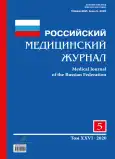Calcification of the basal ganglia: ethiopathogenetic, clinical, and therapeutic aspects
- 作者: Damulin I.V.1,2, Andreev A.D.2
-
隶属关系:
- Medical Institute of Peoples’ Friendship University of Russia
- I.M. Sechenov First Moscow State Medical University (Sechenov University)
- 期: 卷 26, 编号 5 (2020)
- 页面: 326-330
- 栏目: Reviews
- URL: https://journals.rcsi.science/0869-2106/article/view/59658
- DOI: https://doi.org/10.17816/0869-2106-2020-26-5-326-330
- ID: 59658
如何引用文章
详细
This article discusses the clinical manifestations, etiology, and pathogenesis of Fahr disease, as well as causes of Fahr syndrome. This condition is characterized by abnormal calcium deposition, most commonly in the basal ganglia. Calcifications are composed not only of calcium, but also of iron, zinc, and aluminum. At present, several basic concepts of Fahr disease etiology have been put forward, and concepts considering genetic mutations have been studied most profoundly. Both Fahr syndrome and Fahr disease demonstrate a very similar clinical picture. Clinical manifestations in patients with this pathology are marked by significant polymorphism; however, the most typical variation of Fahr disease is the association of motor functions and mental disorders. As for motor functions disorders, Parkinsonism accounts for more than half of the cases. With regards to this pathology, this article considers the key diagnostic criteria and potential of brain computed tomography and magnetic resonance tomography. At present, pathogenetic treatment of Fahr disease does not exist, while Fahr syndrome therapy is focused on diagnostics and treatment of the underlying disease. Pharmacotherapy treatment for Fahr disease is targeted at anxiety and depression relief, as well as reduction of motor functions disorder manifestation.
作者简介
Igor Damulin
Medical Institute of Peoples’ Friendship University of Russia; I.M. Sechenov First Moscow State Medical University (Sechenov University)
编辑信件的主要联系方式.
Email: damulin@mmascience.ru
ORCID iD: 0000-0003-4826-5537
MD, PhD, DSc, Professor
俄罗斯联邦, 117198, Moscow; 119991, MoscowAlexandr Andreev
I.M. Sechenov First Moscow State Medical University (Sechenov University)
Email: alex10_97@mail.ru
俄罗斯联邦, 119991, Moscow
参考
- Manyam B.V., Bhatt M.H., Moore W.D., Devleschoward A.B., Anderson D.R., Calne D.B. Bilateral strio-pallido-dentate calcinosis: cerebrospinal fluid, imaging, and electrophysiological studies. Ann. Neurol. 1992;31(4):379-84. doi: 10.1002/ana.410310406.
- Abubakar S., Saidu S. Idiopathic bilateral strio-pallido-dentate calcinosis (Fahr’s disease): a case report and review of the literature. Ann. Afr. Med. 2012;11(4):234-7. doi: 10.4103/1596-3519.102855.
- Al-Jehani H., Ajlan A., Sinclair D. Fahr’s disease presenting with aneurysmal subarachnoid hemorrhage. J. Clin. Imaging Sci. 2012;2:27. doi: 10.4103/2156-7514.96542.
- Manyam B.V. What is and what is not ‘Fahr’s Disease’. Parkinsonism Relat. Disord. 2005;11(2):73-80. doi: 10.1016/j.parkreldis.2004.12.001.
- Caraceni T., Broggi G., Avanzini G. Familial idiopathic basal ganglia calcification exhibiting “dystonia musculorum deformans” features. Eur. Neurol. 1974;12(5-6):351-9. doi: 10.1159/000114632.
- Ahad M.A., Bala C., Karim S. Fahr's syndrome. Bangladesh Med. J. 2013;45(1-2):33-5. doi: 10.3329/bmjk.v45i1-2.13628.
- Asokan A.G., D'Souza S., Jeganathan J., Pai S. Fahr’s syndrome – an interesting case presentation. J. Clin. Diagn. Res. 2013;7(3):532-3. doi: 10.7860/JCDR/2013/4946.2814.
- Saleem S., Aslam H.M., Anwar M., Anwar S., Saleem M., Saleem A., Rehmani M.A. Fahr’s syndrome: literature review of current evidence. Orphanet. J. Rare Dis. 2013;8:156. doi: 10.1186/1750-1172-8-156.
- Chawla N., Gogia A., Kakar A. Fahr's disease as a presentation of progressive neurodegenerative disorder in an elderly: a case report. Curr. Med. Res. Pract. 2014;4(3):123-5. doi: 10.1016/j.cmrp.2014.04.004.
- Donzuso G., Mostile G., Nicoletti A., Zappia M. Basal ganglia calcifications (Fahr’s syndrome): related conditions and clinical features. Neurol. Sci. 2019;40(11):2251-63. doi: 10.1007/s10072-019-03998-x.
- Durand M., Dollfus H., Koob M., Laugel V., Fothergill H., Dalloz C., et al. Neuroimaging in Cockayne syndrome. AJNR Am. J. Neuroradiol. 2010;31(9):1623-30. doi: 10.3174/ajnr.A2135.
- Batla A., Tai X., Schottlaender L., Erro R., Balint B., Bhatia K. Deconstructing Fahr's disease/syndrome of brain calcification in the era of new genes. Parkinsonism. Relat. Disord. 2017;37:1-10. doi: 10.1016/j.parkreldis.2016.12.024.
- Keller A., Westenberger A., Sobrido M.J., García-Murias M., Domingo A., Sears R.L., et al. Mutations in the gene encoding PDGF-B cause brain calcifications in humans and mice. Nat. Genet. 2013;45(9):1077-82. doi: 10.1038/ng.2723.
- Wang C., Li Y., Shi L., Ren J., Patti M., Wang T., et al. Mutations in SLC20A2 link familial idiopathic basal ganglia calcification with phosphate homeostasis. Nat. Genet. 2012;44(3):254-6. doi: 10.1038/ng.1077.
- Legati A., Giovannini D., Nicolas G., Lopez-Sanchez U., Quintans B., Oliveira J.R., et al. Mutations in XPR1 cause primary familial brain calcification associated with altered phosphate export. Nat. Genet. 2015;47(6):579-81. doi: 10.1038/ng.3289.
- Jaworski K., Styczynska M., Mandecka M., Walecki J., Kosior D.A. Fahr syndrome – an important piece of a puzzle in the differential diagnosis of many diseases. Pol. J. Radiol. 2017;82:490-3. doi: 10.12659/PJR.902024.
- Pistacchi M., Gioulis M., Sanson F., Marsala S.M. Fahr’s syndrome and clinical correlation: a case series and literature review. Folia Neuropathol. 2016;54(3):282-94. doi: 10.5114/fn.2016.62538.
- Alshomrani M.D., Thamer A., Shuqdar R.M. Fahr's disease vs. drug induced movement disorder: case report and literature review. J. Taibah Univ. Med. Sci. 2010;5(2):120-6. doi: 10.1016/s1658-3612(10)70141-4.
- Lazar M., Ion D., Streinu-Cercel A., Badarau A. Fahr's syndrome: diagnosis issues in patients with unknown family history of disease. Rom. J. Morph. Embryol. 2009;50(3):425-428.
- Govindarajan A. Imaging in Fahr's disease: how CT and MRI differ? BMJ Case Reports. 2013;2013:bcr2013201523. doi: 10.1136/bcr-2013-015231.
- Friede, R.L., Magee K.R., Mack E.W. Idiopathic nonarteriosclerotic calcification of cerebral vessels. Arch. Neurol. 1961;5(3):279. doi: 10.1001/archneur.1961.00450150045006.
补充文件






